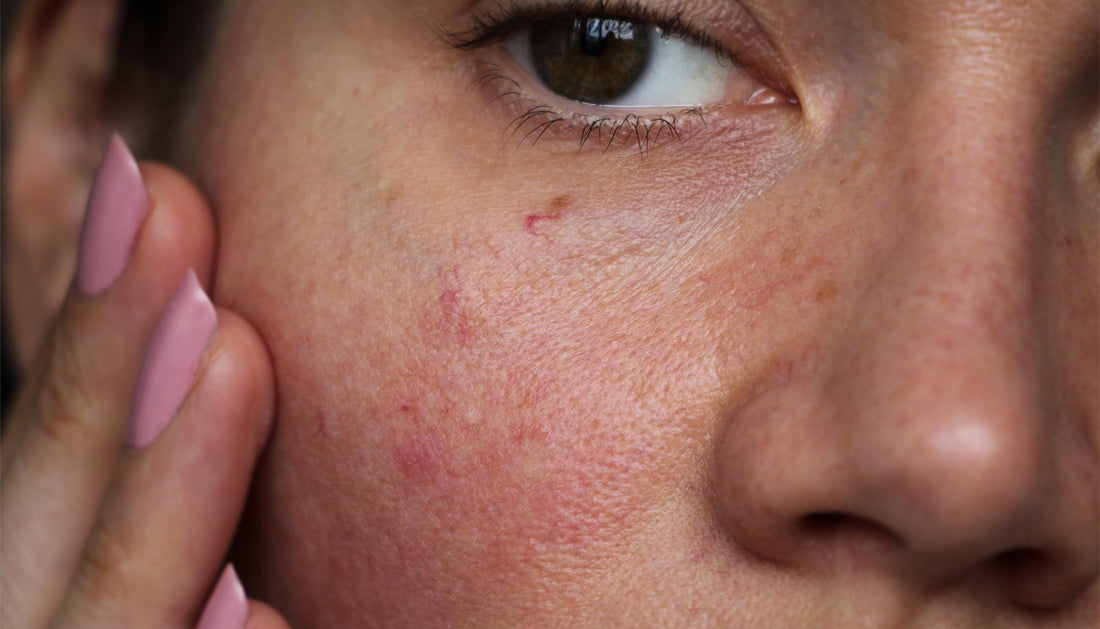Do you experience skin discomfort? Irritation, stinging, tight, dry, or flaking or perhaps redness, heat or burning? There are many symptoms and degrees of skin sensitivity and in this blog, we’ll help boost your confidence in treating this challenging skin condition.
The definition of sensitive skin
“A term used by individuals who consider themselves to be more intolerant of topical preparations, and environmental conditions than the general population”. This statement is broad and unfortunately there is no concise and agreed upon definition among the general public and the medical community. What we do know is that over 50% of the global population consider themselves to have sensitive skin and this figure continues to rise.
What does sensitive skin look like?
When it comes to diagnosing a sensitive skin, as a Professional Skin Therapist there are a few things we look to uncover during your consultation. We try to determine whether you have a genetically sensitive skin type, that you were born with or whether your skin sensitivity has been acquired via your lifestyle or other factors such as the climate. Let’s look at the key differences between a sensitive and sensitised skin.
Sensitive skin – a genetic skin type. You are born with a defective skin barrier, are likely to be intolerant to topical products and may have associated allergies such as hay fever, and be prone to inflammatory skin disorders like eczema, rosacea, and psoriasis. This skin type needs lifelong, daily management.
Sensitised skin – an acquired skin condition. This is related to the effects of your lifestyle and environment. Skin sensitivity can affect all skin types and the triggers are numerous.
- Lifestyle – High stress levels, poor sleep, spicy foods, alcohol, smoking, time outdoors in the elements are all factors that can heighten nerve responses or damage the skin’s protective barrier.
- Environment – Pollution, UV exposure, high or low humidity, harsh weather, central heating, and air conditioning can all contribute to skin irritation and barrier damage.
- Topical products – Over-exfoliation, excessive use of acids or retinoids, stripping cleansers and drying spot treatments are all examples of ways we may be inadvertently sensitising our skin.
Follow the Less Rule
Less is more when it comes to treating sensitive skin. Here are some simple rules to help adapt your regimen when having a flare up.
- Less heat – Avoid hot water when bathing and washing your face, products that heat up and sauna and steam rooms. Be conscious of your pressure when touching your face so as not to stimulate blood flow.
- Less time – Reduce the amount of time you spend on your skin. Pair back your regimen steps and simplify your routine.
- Less friction – Avoid scrubs and formulas with abrasive particles, rough flannels, and face brushes. Be gentle with applying and removing products from the skin. Try cool, damp cotton or a soft cloth.
- Less product – Reduce the number of products in your regimen. Use one cleanser for your double cleanse rather than two different ones and reduce use of exfoliating formulas.
The UltraCalming solution
Our UltraCalming line provides serious relief for sensitive skin. Formulated with the best of science and nature’s pharmacy the UltraCalming formulas contain an ingredient complex to fortify skin's protective barrier for healthier skin. Every UltraCalming product is formulated without lanolin, SD alcohol, mineral oil, artificial fragrances or colours, which can make sensitive skin worse.
3 steps to calmer skin
PREP
Cleanse skin with UltraCalming Cleanser. This cooling gel/cream cleanser is sulphate free and can be used with or without water to gently cleanse the most delicate skins.
TREAT
Reduce redness and cool the skin with the hydrating UltraCalming Mist. Spritz onto clean skin and throughout the day to calm flare-ups. Add a layer of UltraCalming Serum Concentrate to reduce irritation and help build skin’s tolerance with a unique peptide.
GLOW
Moisturise with Stabilizing Repair Cream: its balmy-cream formula melts into skin to give it stability, relief, and a chance to recover from sensitivity. It also features a Ceramide-Building Complex that provides nourishing lipids, strengthening skin’s barrier to lock in moisture and help keep signs of sensitivity at bay.
During the day, complete your regimen with Invisible Physical Defence SPF30 to defend against damaging UV rays. This ‘chemical free’ sunscreen also defends against blue light and contains bio-active Mushroom Complex to soothe skin and reduce UV-induced redness and dryness.
In the hands of a PRO

Visit your local Professional Skin Therapist for a PRO Calm service. This treatment targets all sensitive skin conditions. Soothing botanical actives provide relief while lymphatic drainage and pressure point massage help to calm a stressed nervous system. Experience visibly calmer skin, reduced redness and skin that feels soft, balanced and hydrated.
Find your Dermalogica Expert here.
For more advice on how to treat your sensitive skin, watch our Instagram live
For personalised advice and to find the right products for your skin, book a free virtual 1-2-1 consultation with Face Mapping or chat live with one of our professional skin therapists here.




